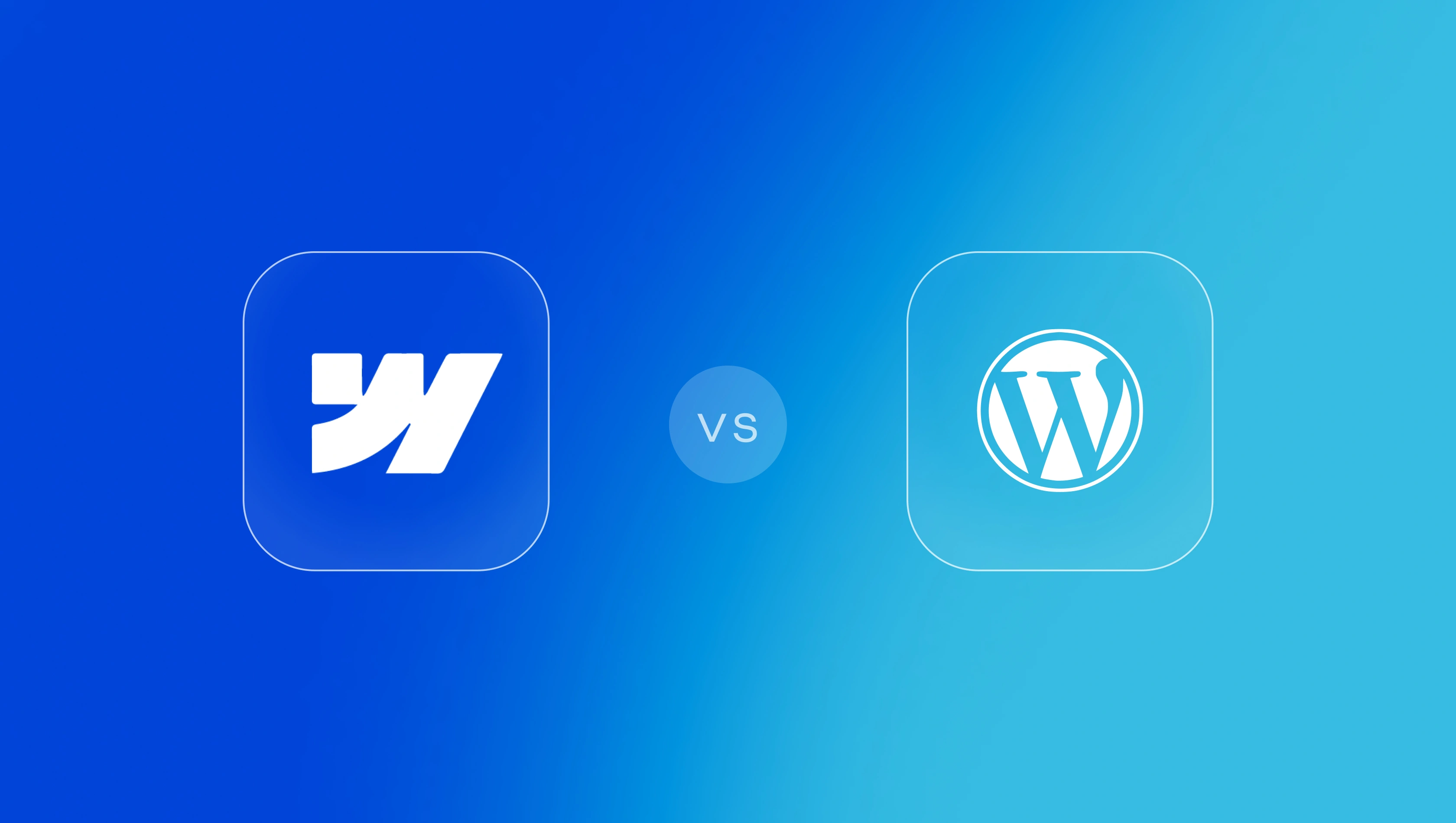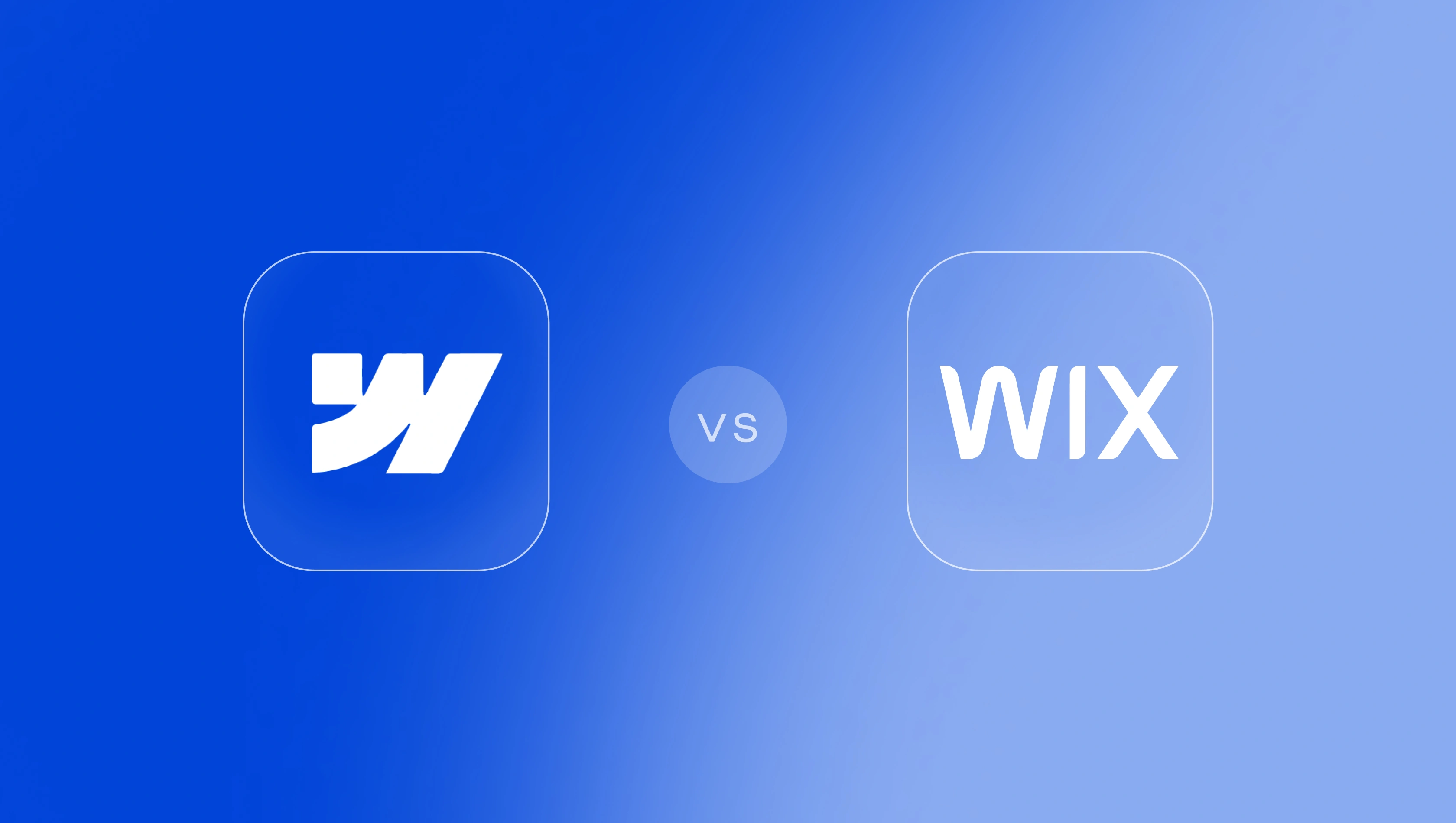Webflow vs. Squarespace: Which is Better?

Choosing the right website builder shapes how a business presents itself online. Among the leading options, Webflow and Squarespace deliver very different approaches to modern website design. Webflow emphasizes creative control, scalability, and precision, while Squarespace focuses on guided templates, ease of use, and convenience. This comparison outlines how each platform supports ecommerce, content management, and day-to-day functionality, helping US businesses select the right foundation for a strong online presence.
What is Webflow?
Webflow is a professional no-code website builder that brings web design, development, and content management together in one visual platform. It produces clean HTML, CSS, and JavaScript, delivering reliable performance and scalability without plug-ins.
The platform operates like a product-design workflow for marketing sites, allowing teams to design, iterate, and publish within the same system. Starting points such as Webflow templates or community cloneables can accelerate setup, but most projects evolve into fully custom websites built with complete design freedom. With flexible CMS collections and native SEO tools, Webflow provides a scalable structure that grows alongside the brand.
What is Squarespace?
Squarespace is an all-in-one website builder known for its polished templates and user-friendly setup. It combines hosting, SSL, and ecommerce features in one place, making it simple to launch a site with minimal configuration. The drag-and-drop interface and fixed layout system help users maintain design consistency without technical expertise. While Squarespace offers reliability and simplicity, its structured templates and limited customization options can restrict flexibility compared with Webflow’s open-ended design environment.
Key Considerations
Design Flexibility
Webflow
Webflow offers deep design flexibility, giving pixel-level control over layouts, animations, and responsive behavior. Designers can visually prototype, adjust interactions, and manage component systems without writing code. The platform’s clean structure keeps performance high and simplifies future updates. Reusable symbols and CMS-driven content make scaling design systems across pages or campaigns efficient and consistent.
Squarespace
Squarespace offers visually refined templates that make site creation straightforward. Its design tools ensure uniformity but limit granular customization. Advanced edits often require injected custom code or developer assistance. For small businesses and startups wanting professional results quickly, this approach offers speed and simplicity though it can feel limiting for teams seeking full creative control.
Build Speed
Webflow
Webflow lets teams move from design to launch faster by removing traditional handoffs between designers and developers. Pages can be built visually, tested, and published directly within the platform. Prebuilt components, Webflow templates, and animations shorten development cycles while maintaining high visual standards. With an integrated CMS, marketing teams can update content instantly and keep campaigns aligned without waiting on code changes.
Squarespace
Squarespace simplifies setup through ready-made templates and an intuitive drag-and-drop editor. Users can launch polished websites quickly, even without prior experience. However, because layouts are structured and less adaptable, complex builds often take longer to refine. For small-scale projects or single-page sites, its simplicity offers speed; for larger builds, the lack of flexibility can slow customization.
SEO
Webflow
Webflow provides advanced SEO tools that allow full control over meta titles, descriptions, sitemaps, and URLs. Its clean HTML and efficient code output improve loading speed and search performance. Built-in optimization features make it easier for teams to implement best practices without additional plug-ins. For growing brands that rely on visibility and control, Webflow offers a scalable, SEO-ready foundation.
Squarespace
Squarespace includes essential SEO features such as mobile responsiveness, SSL certificates, and clean URL structures. Its automation simplifies setup but allows less granular control for technical users. While it performs well for small websites, larger brands or content-heavy platforms may find its built-in tools limiting for long-term optimization.
Security & Maintenance
Webflow
Webflow hosting is fully managed, with automatic updates, SSL, and global CDN delivery ensuring fast and secure performance. Users don’t handle servers, plug-ins, or patches, which reduces maintenance overhead and risk. For marketing teams, this structure means fewer dependencies and more time spent on content and design.
Squarespace
Squarespace provides similar managed security, including automatic updates, SSL, and 24/7 uptime monitoring. Its closed system limits exposure to third-party vulnerabilities, though it also restricts custom integrations. The platform is ideal for businesses prioritizing simplicity and security without needing detailed technical control.
Ease of Use
Webflow
Webflow takes time to learn but offers unmatched freedom once mastered. Its interface feels familiar to designers, reflecting how visual tools like Figma or Sketch function. Learning to use Webflow allows teams to build with precision and autonomy, bridging design and development. While it’s not as beginner-friendly as Squarespace, it enables deeper customization options and faster workflows for established teams.
Squarespace
Squarespace is the more beginner-friendly option, offering guided templates and a clear visual editor. Its structured approach keeps sites consistent and reduces errors, making it ideal for small businesses or individuals managing their own websites. However, that same simplicity limits creative experimentation or advanced functionality.
Website Hosting
Webflow
Webflow hosting is managed end-to-end for speed and reliability. Sites are distributed through a global CDN with built-in SSL, automatic backups, and version history. Teams don’t need external hosting or plug-ins, which simplifies operations and minimizes risk. Consistent uptime and fast delivery ensure dependable performance for both marketing and enterprise-scale websites.
Squarespace
Squarespace hosting is included with every plan, giving users a simple all-in-one solution. It automatically manages SSL, caching, and performance updates without user input. While reliable, there’s limited ability to customize or switch infrastructure. For small businesses or individuals, its convenience outweighs the lack of flexibility, but advanced teams may find it restrictive.
Scalability & Future-Proofing
Webflow
Webflow offers scalability through reusable components, CMS collections, and modular page systems. These tools make it easy to add new content, sections, or campaigns without reworking existing layouts. As organizations grow, Webflow supports multi-language builds and evolving design systems, making it a long-term platform that scales with both content and teams.
Squarespace
Squarespace supports moderate scaling but becomes less efficient as site complexity grows. Its framework is ideal for small to mid-sized businesses but restrictive for large content libraries or advanced features. Expanding functionality often requires external integrations or custom code. It’s best suited for stable websites that don’t change frequently.
Integrations
Webflow
Webflow integrates seamlessly with CRMs, analytics platforms, and marketing automation tools through native connections or services like Zapier and Make. Its custom code capability allows developers to embed scripts, connect APIs, or extend site functionality while maintaining performance. This flexibility makes Webflow a strong choice for data-driven teams and growing digital ecosystems.
Squarespace
Squarespace includes built-in email marketing, commerce, and social media integrations, which simplify setup for smaller teams. However, its closed ecosystem limits third-party expansion. Businesses that rely on advanced tracking or CRM workflows may find it lacks the extensibility offered by Webflow.
Team Collaboration & Workflows
Webflow
Webflow supports multi-user collaboration through workspace roles and content editing permissions. Designers, developers, and marketers can work simultaneously without overwriting changes. The CMS enables real-time updates, while Editor mode allows marketing teams to publish content independently. This structure mirrors modern product workflows, improving efficiency and accountability.
Squarespace
Squarespace allows collaboration via shared logins and user roles. It works well for small teams but lacks the robust version control and concurrent editing that Webflow supports. Content changes are usually made sequentially, which can slow iteration for larger teams managing multiple pages or campaigns.
Content Localization
Webflow
Webflow includes native localization tools for managing multilingual content within a single project. Each region can have its own URLs, SEO settings, and site structure, ensuring clarity for users and search engines. For global organizations, this eliminates the need for external translation plug-ins or duplicate projects.
Squarespace
Squarespace supports localized content through manual duplication or third-party apps. While manageable for smaller sites, this approach becomes cumbersome as page volume or language count grows. It remains practical for single-language websites but isn’t designed for enterprise-level localization.
Customer Support
Webflow
Webflow provides extensive resources, including Webflow University, tutorials, and a large community forum. Direct email support assists with technical and account issues. The platform’s self-service resources make it easy for teams to learn and troubleshoot independently, speeding up adoption and ongoing management.
Squarespace
Squarespace offers 24/7 live chat and email support, plus a detailed knowledge base covering setup, templates, and ecommerce features. The support experience is reliable and accessible, but technical depth is limited compared with platforms built for professional teams.
Pricing
Webflow
Webflow’s pricing scales with project size and functionality. Plans range from simple static websites to advanced CMS and ecommerce builds. Each Webflow site can expand through additional workspace seats or localization features as teams grow. There’s no permanent free plan, but users can explore the platform on a limited trial tier. Webflow offers transparent, flexible pricing plans designed for professional workflows.
Squarespace
Squarespace pricing is straightforward, combining hosting, SSL, and built-in ecommerce features under one monthly subscription. A short free plan trial lets users test functionality before upgrading. Packages include email marketing, analytics, and SEO tools, making it cost-effective for smaller businesses. Its simplicity suits startups and freelancers but offers less flexibility for large or custom builds.
Enterprise Solutions
Webflow
Webflow Enterprise delivers security, scalability, and collaboration tools for high-traffic or multi-region organizations. Custom SLAs, advanced roles, and dedicated support ensure reliability at scale. Combined with its CMS, Webflow empowers marketing and product teams to manage complex digital ecosystems with creative freedom and technical precision.
Squarespace
Squarespace provides business-grade plans that include commerce and analytics, but its enterprise capabilities are limited compared with Webflow. It focuses on simplicity over system-level customization, making it best for content-driven companies that value convenience rather than technical depth.
Webflow: Pros & Cons
Pros
Design freedom
Webflow gives full visual control over layouts, animations, and responsive behavior. Designers can translate creative direction into precise results, creating branded, performance-focused websites without relying on plug-ins.
Clean performance
The platform outputs semantic HTML, CSS, and JavaScript, improving site speed, accessibility, and visibility in search engines. Clean code also makes ongoing optimization and scaling easier.
Built-in CMS
Webflow’s CMS is structured for growth. Teams can design around dynamic content, update pages at scale, and maintain design consistency without developer dependency.
Marketing integrations
Webflow integrates seamlessly with analytics and marketing tools like HubSpot or Google Tag Manager. Automation and campaign tracking can run natively, helping marketing teams stay agile.
Reusable components
Symbols, classes, and global styles create consistency across large builds. Teams can make universal design changes without repetitive edits.
Scalable architecture
Modular design systems and CMS templates make expanding new sections or campaigns fast and low-risk. Webflow sites can evolve without restructuring.
Native localization
Integrated localization supports multilingual sites and region-specific content, simplifying international scalability without external plug-ins.
Cons
Learning curve
Webflow requires time to master its layout logic and box-model approach. Designers or marketers unfamiliar with CSS structure may need onboarding before working efficiently.
Technical knowledge
While it’s a no-code tool, deeper customization benefits from basic HTML, CSS, or JavaScript understanding, particularly for advanced animations or integrations.
Limited plug-ins
Webflow has fewer one-click extensions than WordPress or Wix, meaning some unique features rely on custom code or third-party integrations.
Higher cost at scale
Professional and enterprise-level plans cost more than typical template builders, though they reflect the platform’s power and performance.
Squarespace: Pros & Cons
Pros
Beginner-friendly setup
Squarespace prioritizes accessibility. Its drag-and-drop editor and guided templates make it simple to design and launch a professional site quickly, even with no prior experience.
All-in-one platform
Everything from hosting to SSL and ecommerce features is bundled in a single subscription, removing setup complexity. The system handles performance updates automatically.
Built-in marketing tools
Squarespace offers integrated email marketing, social media connections, and analytics dashboards, ideal for small teams managing campaigns within one ecosystem.
Predictable pricing
Flat pricing plans simplify budgeting and maintenance, with no need for external hosting or plug-ins.
Reliable support
24/7 chat and email assistance are backed by a detailed knowledge base and tutorial library, ensuring dependable user support.
Cons
Limited design flexibility
While Squarespace templates look professional, customization is restricted. Complex layouts or brand-specific adjustments often require injected custom code.
Scalability limits
The platform is optimized for smaller sites. As businesses expand, limitations in content organization and performance can emerge.
Optimization restrictions
Basic SEO tools handle essentials but provide little control for advanced targeting, structured data, or large-scale optimization.
Fewer integrations
Squarespace integrates well within its own ecosystem but offers fewer options for connecting with third-party apps, CRMs, or marketing stacks.
Webflow vs Squarespace Summary
Webflow and Squarespace both deliver strong foundations for building a modern website, yet they serve different audiences and goals. Squarespace emphasizes simplicity through guided templates, built-in hosting, and quick setup. Ideal for individuals and small businesses that want a consistent, low-maintenance presence. Its all-in-one design makes setup predictable but limits deep customization, scaling, and brand differentiation as needs evolve.
Webflow offers the precision and flexibility required by creative teams, startups, and established organizations. Its visual designer, modular CMS, and advanced SEO tools enable design systems that adapt and grow. As businesses scale, Webflow provides the structure to manage complex content, support integrations, and maintain consistent performance.
For companies seeking long-term creative freedom and technical reliability, Webflow offers the most adaptable platform for modern digital experiences—let’s talk.
FAQs
What makes Webflow a professional website builder?
Webflow combines web design, development, and content management in one system. Its visual interface mirrors real code, producing clean HTML, CSS, and JavaScript for performance and search visibility. Teams can launch custom websites, manage structured content, and scale design systems as their brand grows. Compared with Squarespace vs Webflow, it offers deeper control, more flexibility, and enterprise-level scalability.
Is Squarespace easier to use than Webflow?
Yes. Squarespace is designed for beginners who want to launch quickly using prebuilt templates and a simple drag-and-drop interface. It’s ideal for small businesses and individuals. Webflow, while more advanced, enables total creative control and reusability once learned. For growing teams that publish frequently, learning to use Webflow creates faster workflows and independence from developers.
Which platform performs better for SEO?
Both platforms include built-in SEO tools, but Webflow allows more precise configuration for meta titles, sitemaps, and semantic markup. Its clean code and optimization control give marketers stronger performance insights. Squarespace offers automated basics, perfect for smaller websites, but less control over advanced SEO settings. For brands competing on content, Webflow’s flexibility delivers longer-term visibility advantages.
Can both platforms support ecommerce?
Yes. Squarespace includes straightforward ecommerce features for small stores, offering built-in checkout, transaction fees, and inventory tracking. Webflow Ecommerce gives full design freedom and deeper customization options, letting brands shape every stage of the shopping experience. It also integrates with marketing tools, CRMs, and third-party logistics, making it ideal for scalable retail operations.
How do pricing plans compare?
Squarespace pricing covers hosting, SSL, and email marketing within one subscription, with a limited free plan trial. It’s cost-effective for smaller businesses. Webflow’s pricing scales by project size, offering flexible site plans and workspace tiers. Though it can cost more upfront, Webflow offers better scalability, performance, and control, especially for long-term or enterprise projects.
Which is better for long-term growth?
Webflow supports long-term growth with modular design systems, a scalable CMS, and flexible custom code options. It’s ideal for companies building structured digital ecosystems that evolve over time. Squarespace works well for small, stable websites but becomes restrictive as needs expand. For ambitious brands prioritizing scalability and creative flexibility, Webflow offers the stronger long-term foundation.




